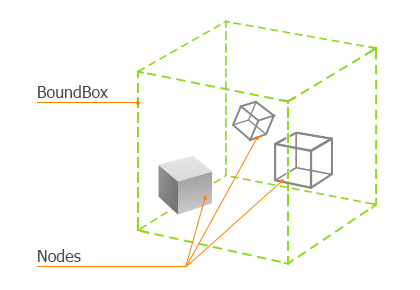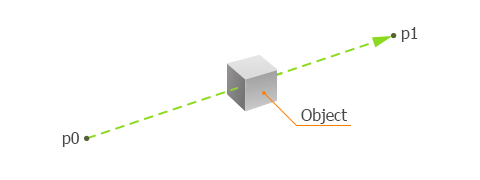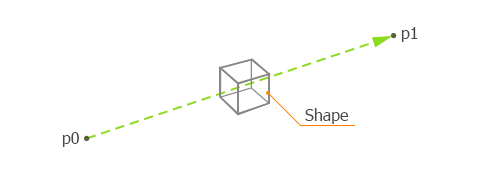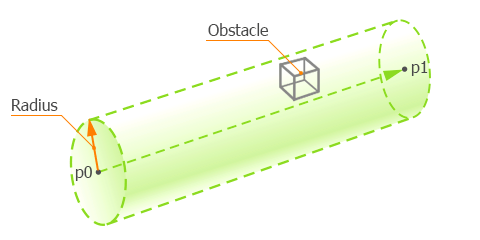Intersections
Unigine has different methods to detect intersections. Intersection is a generic point of the defined area (or line) and an object. This article describes different types of intersections and their usage.
There are three main types of intersections:
- World intersection - an intersection with objects and nodes.
- Physics intersection - an intersection with shapes and collision objects.
- Game intersection - an intersection with pathfinding nodes like obstacles.
Shape and Object classes have their own getIntersection() functions. They are used for detecting intersections with the specific shape or the specific surface of the object.
World Intersection
By using different overloaded World class getIntersection() functions you can find objects and nodes that intersect bounds of the specified bounding volume or find the first intersection of the object with the invisible tracing line.
World class functions for intersection search can be divided into 3 groups:
- Functions to find nodes within a bounding volume.
- Functions to find objects within a bounding volume or intersected with a traced line.
- Functions to find first intersected object with a traced line.
Intersection with Nodes
To find the intersection of nodes with bounds of the specified volume, you should use functions that have a bounding volume and a vector of nodes in arguments:
- int getIntersection(WorldBoundBox bb, ICollection<Node> nodes)
- int getIntersection(WorldBoundSphere bs, ICollection<Node> nodes)
- int getIntersection(WorldBoundBox bb, int type, ICollection<Node> nodes)
- int getIntersection(WorldBoundSphere bs, int type, ICollection<Node> nodes)
- int getIntersection(WorldBoundFrustum bf, int type, ICollection<Node> nodes)

These functions return the value indicating the result of the intersection search: 1 if the intersection was found; otherwise, 0. Intersected nodes can be found in the collection that passed as an argument to the function.
To clarify the nodes search, perform the following:
- Specify the type of node to search.
Usage Example
In the example below, the engine checks intersections with a bounding box and shows the message in the console.
In the init() function the bounding box is defined.
The main logic is in the update() method: the engine checks the intersection and shows the message about intersection.
// AppWorldLogic.cs
using System;
using System.Collections.Generic;
using System.Linq;
using System.Text;
using Unigine;
namespace UnigineApp
{
class AppWorldLogic : WorldLogic
{
// define a bounding box
WorldBoundBox boundBox;
// create a counter to show the message once
int counter = 1;
public override int init()
{
// initialize the bounding box
boundBox = new WorldBoundBox(new dvec3(0.0f), new dvec3(10.0f));
return 1;
}
public override int update()
{
// check the intersection with the bounding box
World world = World.get();
List<Node> nodes = new List<Node>();
int result = world.getIntersection(boundBox, nodes);
if (result !=0 && counter !=0)
{
foreach(Node n in nodes)
{
// show the name of the intersected node in the console
Log.message("There was an intersection with: {0} \n", n.getName());
}
counter--;
}
return 1;
}
/* ... */
}
}Intersection with Objects
The following functions can be used to perform the intersection search with objects:
- int getIntersection(Vec3 p0, Vec3 p1, ICollection<Object> objects)
- int getIntersection(WorldBoundBox bb, ICollection<Object> objects)
- int getIntersection(WorldBoundSphere bs, ICollection<Object> objects)
- int getIntersection(WorldBoundFrustum bf, ICollection<Object> objects)

These functions return the value indicating the result of the intersection search: 1 if the intersection was found; otherwise, 0. You can pass the start (vec3 p0) and the end (vec3 p1) point of the intersecting line or pass the (BoundBox, BoundFrustum, BoundSphere) to get the intersection of objects with a line or with a bounding volume, respectively. Intersected nodes can be found in the collection that passed as an argument to the function.
Usage Example
In the example below, the engine checks intersections with a bounding box and shows the message in the console.
In the init() function the bounding box is defined.
The main logic is in the update() method: the engine checks the intersection and shows the message about intersection.
// AppWorldLogic.cs
using System;
using System.Collections.Generic;
using System.Linq;
using System.Text;
using Unigine;
namespace UnigineApp
{
class AppWorldLogic : WorldLogic
{
// define a bounding box
WorldBoundBox boundBox;
// create a counter to show the message once
int counter = 1;
public override int init()
{
// initialize the bounding box
boundBox = new WorldBoundBox(new dvec3(0.0f), new dvec3(10.0f));
return 1;
}
public override int update()
{
// check the intersection with the bounding box
World world = World.get();
List<Unigine.Object> objects = new List<Unigine.Object>();
int result = world.getIntersection(boundBox, objects);
if (result != 0 && counter != 0)
{
foreach (Unigine.Object o in objects)
{
Log.message("There was an intersection with: {0} \n", o.getName());
}
counter--;
}
return 1;
}
/* ... */
}
}First Intersected Object
The following functions are used to find the nearest intersected object with the traced line. You should specify the start point and the end point of the line, and the function detects if there are any object on the way of this line.
- Object getIntersection(Vec3 p0, Vec3 p1, int mask, Vec3[] ret_point, vec3[] ret_normal, vec4[] ret_texcoord, int[] ret_index, int[] ret_surface)
- Object getIntersection(Vec3 p0, Vec3 p1, int mask, Node[] exclude, Vec3[] ret_point, vec3[] ret_normal, vec4[] ret_texcoord, int[] ret_index, int[] ret_surface)
- Object getIntersection(Vec3 p0, Vec3 p1, int mask, WorldIntersection v)
- Object getIntersection(Vec3 p0, Vec3 p1, int mask, WorldIntersectionNormal v)
- Object getIntersection(Vec3 p0, Vec3 p1, int mask, WorldIntersectionTexCoord v)
- Object getIntersection(Vec3 p0, Vec3 p1, int mask, Node[] exclude, WorldIntersection v)
- Object getIntersection(Vec3 p0, Vec3 p1, int mask, Node[] exclude, WorldIntersectionNormal v)
- Object getIntersection(Vec3 p0, Vec3 p1, int mask, Node[] exclude, WorldIntersectionTexCoord v)

These functions return an intersection information and a pointer to the nearest object to the start point (p0). Information about the intersection can be presented in standard vectors or in the following format that you pass to functions as arguments:
- WorldIntersection intersection - the WorldIntersection class instance. By using this class you can get the intersection point (coordinates), the index of the intersected triangle of the object and the index of the intersected surface.
- WorldIntersectionNormal normal - the WorldIntersectionNormal class instance. By using this class you can get only the normal of the intersection point.
- WorldIntersectionTexCoord texcoord - the WorldIntersectionTexCoord class instance. By using this class you can get only the texture coordinates of the intersection point.
These functions detect intersection with surfaces (polygons) of meshes. But there are some conditions to detect the intersection with the surface:
- The surface is enabled.
- The surface has a material assigned.
- Per-surface Intersection flag is enabled.
NoticeYou can set this flag to the object's surface by using the Object.setIntersection() function.
- A property inherited from the surface_base is assigned to the surface and the intersection parameter of this property is set to 1.
NoticeYou can set this parameter via the setParameterInt() method function.
To clarify the object search, perform the following:
- Use an intersection mask. An intersection is found only if an object is matching the intersection mask.
- Specify the list of objects (nodes) to exclude and pass to the function as an argument.
Usage Example
In the example below, the engine checks intersections with a bounding box and shows the message in the console.
In the init() function the bounding box is defined.
The main logic is in the update() method: the engine checks the intersection and shows the message about intersection.
// AppWorldLogic.cs
using System;
using System.Collections.Generic;
using System.Linq;
using System.Text;
using Unigine;
namespace UnigineApp
{
class AppWorldLogic : WorldLogic
{
// define world intersection instance
WorldIntersection wi;
// create a counter to show the message once
int counter = 1;
public override int init()
{
// initialize the world intersection
wi = new WorldIntersection();
return 1;
}
public override int update()
{
// check the intersection with the bounding box
World world = World.get();
Unigine.Object o = world.getIntersection(new dvec3(0.0f), new dvec3(1.0f), 1, wi);
if (o != null && counter != 0)
{
Log.message("The name of the obstacle is: {0} \n", o.getName());
counter--;
}
return 1;
}
/* ... */
}
}Physics Intersection
Physics intersection function detects the intersection with a shape of bodies. If the object has no body, this function detects intersection with surfaces (polygons) of the object with intersection flag. When you need to find the intersection with the shape of the object (not with polygons), the intersection function of Physics class is the best way to get it.

There are 4 functions to find physics intersections:
- Object getIntersection(Vec3 p0, Vec3 p1, int mask, PhysicsIntersection intersection)
- Object getIntersection(Vec3 p0, Vec3 p1, int mask, PhysicsIntersectionNormal intersection)
- Object getIntersection(Vec3 p0, Vec3 p1, int mask, Node[] exclude, PhysicsIntersection intersection)
- Object getIntersection(Vec3 p0, Vec3 p1, int mask, Node[] exclude, PhysicsIntersectionNormal intersection)
Thus, to exclude some obstacles you should use these methods:
- Use an intersection mask. An intersection is found only if an object is matching the intersection mask, otherwise it is ignored.
- Specify the list of objects to exclude and pass to the function as an argument.
Usage Example
The following example shows how you can get the intersection information by using the PhysicsIntersection class. In this example we specify a line from the point of the camera (vec3 p0) to the point of the mouse pointer (vec3 p1). The executing sequence is the following:
- Define and initialize two points (p0 and p1) by using the Player.getDirectionFromScreen() function.
- Create an instance of the PhysicsIntersection class to get the intersection information.
- Check, if there is an intersection with an object with a shape or a collision object. The getIntersection() function returns an intersected object when the object intersects with the traced line.
- In this example, when the object intersects with the traced line, all the surfaces of the intersected object change their material parameters. If the object has a shape, its information will be shown in console. The PhysicsIntersection class instance gets the coordinates of the intersection point and the Shape class object. You can get all these fields by using getShape(), getPoint() functions.
// AppWorldlogic.cs
using Unigine;
#if UNIGINE_DOUBLE
using Vec3 = Unigine.dvec3;
using Vec4 = Unigine.dvec4;
using Mat4 = Unigine.dmat4;
#else
using Vec3 = Unigine.vec3;
using Vec4 = Unigine.vec4;
using Mat4 = Unigine.mat4;
#endif
namespace UnigineApp
{
class AppWorldLogic : WorldLogic
{
ObjectMeshDynamic dynamic_mesh;
public override int init()
{
// create a mesh instance with a box surface
Mesh mesh = new Mesh();
mesh.addBoxSurface("box", new vec3(2.2f));
// create a new dynamic mesh from the Mesh instance and add it to editor
dynamic_mesh = new ObjectMeshDynamic(mesh);
dynamic_mesh.release();
Editor.get().addNode(dynamic_mesh.getNode());
// assign a material and a property to the dynamic mesh
dynamic_mesh.setWorldTransform(MathLib.translate(new Vec3(0.0f, 0.0f, 2.0f)));
dynamic_mesh.setMaterial("mesh_base", "*");
dynamic_mesh.setProperty("surface_base", "*");
// assign a body and a shape to the dynamic mesh
BodyRigid body = new BodyRigid(dynamic_mesh);
ShapeBox shape = new ShapeBox(body, new vec3(2.2f));
return 1;
}
public override int update() {
// initialize points of the mouse direction
Vec3 p0, p1;
// get the current player (camera)
Player player = Game.get().getPlayer();
if (player == null)
return 0;
// get width and height of the current application window
int width = App.get().getWidth();
int height = App.get().getHeight();
// get the current X and Y coordinates of the mouse pointer
int mouse_x = App.get().getMouseX();
int mouse_y = App.get().getMouseY();
// get the mouse direction from the player's position (p0) to the mouse cursor pointer (p1)
player.getDirectionFromScreen(out p0, out p1, mouse_x, mouse_y, width, height);
// create the instance of the PhysicsIntersection object to save the information about the intersection
PhysicsIntersection intersection = new PhysicsIntersection();
// get an intersection
Unigine.Object obj = Physics.get().getIntersection(p0, p1, 1, intersection);
// if the intersection has been occurred, change the parameter of the object's material
if (obj != null)
{
for (int i = 0; i < obj.getNumSurfaces(); i++)
{
obj.setMaterialParameter("albedo_color", new vec4(1.0f, 1.0f, 0.0f, 1.0f), i);
}
// if the intersected object has a shape, show the information about the intersection
Shape shape = intersection.getShape();
if (shape != null)
{
Log.message("physics intersection info: point: ({0} {1} {2}) shape: {3}\n", intersection.getPoint().x, intersection.getPoint().y, intersection.getPoint().z, shape.getType().GetType());
}
}
return 1;
}
}
}Game Intersection
Game class getIntersection() functions are used to check the intersection with obstacles (pathfinding nodes):
- Obstacle getIntersection(Vec3 p0, Vec3 p1, float radius, int mask, Node[] exclude, Vec3[] intersection)
- Obstacle getIntersection(Vec3 p0, Vec3 p1, float radius, int mask, GameIntersection intersection)
The engine creates an invisible cylinder with specified radius between two points and checks if an obstacle is presented inside of it.

These functions return an intersection information and a pointer to the nearest obstacle to the start point (p0). Information about the intersection will be presented in the GameIntersection class instance which you pass to the function as an argument or in the vector.
Use mask and exclude arguments of the overloaded function to specify the obstacle search.
To clarify the obstacle search, perform the following:
- Use an obstacle intersection mask. An intersection is found only if an object is matching the intersection mask, otherwise it is ignored.
- Specify the list of obstacles to exclude and pass to the function as an argument.
Usage Example
In the example below, the engine checks intersections with a obstacle box and shows the message in the console.
In the init() function the obstacle box is initialized.
The main logic is in the update() method: the engine checks the intersection and shows the message about the intersection.
// AppWorldLogic.cs
using System;
using System.Collections.Generic;
using System.Linq;
using System.Text;
using Unigine;
namespace UnigineApp
{
class AppWorldLogic : WorldLogic
{
// define an obstacle box and game intersection instance
ObstacleBox obstacleBox;
GameIntersection gi;
// create a counter to show the message once
int counter = 1;
public override int init()
{
// initialize the obstacle box and specify the name
obstacleBox = new ObstacleBox(new vec3(1.0f));
obstacleBox.setName("main_obstacle");
// initialize the game intersection object
gi = new GameIntersection();
return 1;
}
public override int update()
{
// check the intersection with the obstacle box
Game game = Game.get();
Obstacle obstacle = game.getIntersection(new dvec3(0.0f), new dvec3(3.0f), 5.0f, 1, gi);
if (obstacle.checkPtr() != null && counter != 0)
{
Log.message("The name of the obstacle is: {0} \n", obstacle.getName());
counter--;
}
return 1;
}
/* ... */
}
}